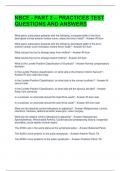NBCE - PART 2 – PRACTICES TEST
QUESTIONS AND ANSWERS
What pelvic subluxation presents with the following: increased width of the ilium,
decreased normal anterior lumbar curve, raises the femur head? - Answer-IN ilium
What pelvic subluxation presents with the following: decreased width of the ilium,
anterior lumbar curve increases, lowers femur head? - Answer-EX ilium
What causes the foot to diverge away from midline? - Answer-IN ilium
What causes the foot to diverge toward midline? - Answer-EX ilium
What is the Lovette Positive Classification of Scoliosis? - Answer-Normal compensatory
deviation
In the Lovette Positive classification, on what side is the Anterior Inferior Sacrum? -
Answer-PI ilium side (short leg)
In the Lovette Positive Classification, on what side is the convex scoliosis? - Answer-AI
sacrum side
In the Lovette Positive Classification, to what side will the spinous deviate? - Answer-
Away from convexity
In a scoliosis, on what side should the heel lift be used? - Answer-PI ilium side
In a scoliosis, on what side should the sole lift be used? - Answer-AS ilium side
What are the absolute contra-indications to adjusting? - Answer-Malignancies, tumors,
infections, fractures, abdominal aortic aneurysm, recent surgery.
What are the relative contra-indications to adjusting? - Answer-Osteoporosis,
Spondylisthesis, Rheumatoid Arthritis, Cardiovascular predisposing factors, congenital
anomalies, acute spastic muscle region.
The ASIS's are in the same plane as the symphysis pubis. - Answer-Balanced Pelvis
The ASIS's move anterior to the pubic symphysis. - Answer-Anterior Pelvic Tilt
The ASIS's move posterior to the pubic symphysis. - Answer-Posterior Pelvic Tilt
, What type of lordosis is seen in an Anterior Pelvic Tilt? - Answer-Hyperlordosis
What type of lordosis is seen in a Posterior Pelvic Tilt? - Answer-Hypolordosis
In an anterior pelvic tilt, what muscles will be lengthened/inhibited? - Answer-
Hamstrings, gluteals, abdominals.
In an anterior pelvic tilt, what muscles are hypertonic/facilitated? - Answer-Psoas,
quadriceps, erector spinae
In a posterior pelvic tilt, what muscles are lengthened/inhibited? - Answer-Psoas,
quadriceps, erector spinae
In a posterior pelvic tilt, what muscles are hypertonic/facilitated? - Answer-Hamstrings,
gluteals, abdominals
In upper cross syndrome, what muscles are hypertonic/facilitated? - Answer-Levator
scapulae, pectoralis major, upper trapezius, sternocleidomastoid, scalenes,
suboccipitals
In upper cross syndrome, what muscles are lengthened/inhibited? - Answer-
Rhomboids, lower & middle trapezius, serratus anterior, teres minor, longus coli and
capitus
In the sub-occipital triangle, where is the Obliquus Capitus Superior located? - Answer-
C1 transverse process to occiput
In the sub-occipital triangle, where is the Obliquus Capitus Inferior located? - Answer-
spinous process of Axis to transverse process of Atlas
In the sub-occipital triangle, where is the Rectus Capitus Posterior Major located? -
Answer-spinous process of Axis to Occiput
In the sub-occipital triangle, where is the Rectus Capitus Posterior Minor located? -
Answer-Posterior tubercle to Occiput
What type of exercise is done non-weight bearing, in which the hand or foot is free to
move? - Answer-Open Chain Exercise
What type of exercise is performed with the hand or foot fixed and cannot move, usually
stays in constant contact with the surface? - Answer-Closed Chain Exercise
When looking at the gravity weight line in an anterior view, what is being assessed? -
Answer-head tilt or rotation, shoulder height, arm carriage, hip height, feet malposition.




